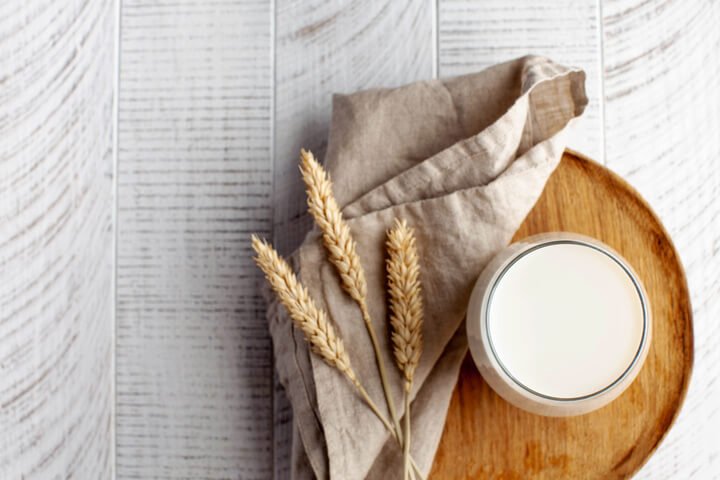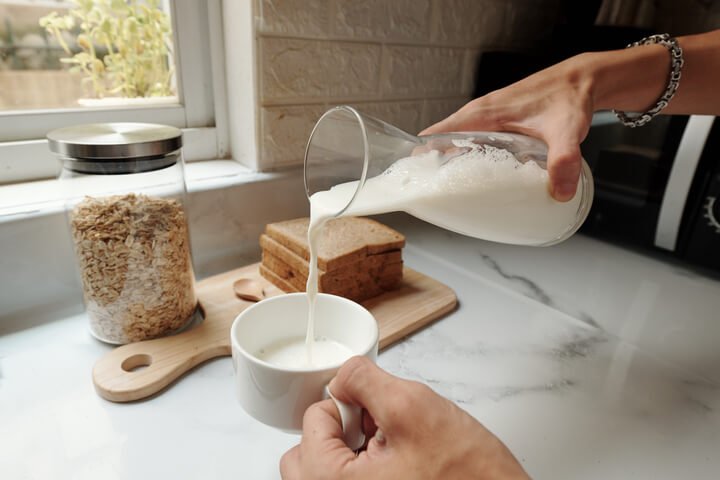Did you know spelt is considered an heirloom grain?
That means it hasn't been processed or genetically modified, and we have passed them down from generation to generation.
People have been using spelt for centuries, if not millennia, and though it became less popular in favor of other grains like wheat, rice, and corn, it is swiftly making a comeback. You can even make milk from it!
If you're asking, what is spelt milk and why do I need to know about it, then keep reading. You won't be disappointed.
What is Spelt Milk?
Spelt is a grain that was initially native to Central Asia. It is the ancestor of wheat as we know it, and in total, there are three different kinds of spelt.
Small spelt is grown in the south of Asia and is often eaten like rice because it is so tender. It has a higher nutritional value than its Northern cousin. The largest form of spelt, and the third of our types, is less digestible and overall less flavorful too.
While spelt has declined in popularity after the arrival of other crops like corn, rice, and wheat, it is still a popular choice around the world for its nutritional quality.
They originally nicknamed it the "wheat of the Gauls," the Gauls being a group of Celtic people originally from Continental Europe (around the 5th century B.C.E to the 5th-century A.C.E). At the time, wheat was rare, so spelt was used largely as the base food for much of European society.
Spelt milk is made from these grains, and most importantly, from something called "spelt berries."
They're nothing like berries, they're simply the kernels of grain and look very similar to wheat in that way. Spelt berries are soaked and blended with water to make spelt milk.
Spelt Milk Nutrition Facts
Spelt actually contains all of the essential amino acids the human body needs to thrive! It also contains several minerals, like iron, zinc, copper, magnesium, and is even said to contain stress-relieving properties.
Let's break down the exact nutritional values.
Spelt Milk Nutrition Facts | |
|---|---|
Calories | 56 |
Protein | 1g |
Fat | 2g |
Carbohydrates | 10g |
Fiber | 0g |
Sugar | 4g |
Spelt milk may also contain iron, magnesium, phosphorous, manganese, zinc, selenium, potassium, thiamin, niacin, folic acid, and vitamin B6.
The Benefits of Spelt Milk
Spelt Milk and Digestive Issues
Because spelt has a high fiber level, it may help with digestion in a big way. Dietary fiber bulks up the stool and helps food move through the digestive system, which speeds up nutrient absorption and perhaps reducing conditions like constipation, bloating, cramps, excess gas, diarrhea, and potentially some serious problems like ulcers.
May Help With Cholesterol
Spelt is also one of the wheat cultivars with the highest dietary fiber content, which has a secondary function in the body (beyond the digestive system), which is to lower the risk of harmful cholesterol.
Dietary fiber can interact with cholesterol uptake pathways and limit cholesterol absorption from the diet. In reality, it can target bad cholesterol and remove it, allowing the body to maintain a healthy fatty acid balance.
Top-Notch Minerals for Bone and Body Health
Because of its nutritional composition, it could help a lot with blood circulation, regulating hormones, and increasing bone health. These come from high iron levels, niacin, and an impressive range of essential minerals vital for bone health.
May Help With Insulin Production and Diabetes
Finally, even though simple sugars and carbohydrates are known to be harmful to diabetics, spelt's high fiber content may help reduce these side effects and regulate the release and breakdown of simple sugars into glucose.
The Downsides of Spelt Milk
Unfortunately, despite how incredible spelt milk can be, there are some downsides to consider. The biggest one is that, unlike a lot of other plant milks, it contains gluten. This means that people suffering from gluten intolerances and allergies should choose other grain or wheat alternatives.
One of the other drawbacks of spelt milk is that taste-wise, it could take some getting used to. It has a decidedly malty taste and smell, which some people may love and others not so much. It does also need to be shaken well before drinking in order to achieve a milky consistency.
How To Make Spelt Milk
Spelt milk is really easy to make, and you can whip up a bottle of this goodness in no time at all. All you need is a blender, something to filter the liquid out, and a clean, sterile container, preferably glass.

Ingredients
- 1 liter of water
- 100g spelt flakes
- 1 tsp vanilla extract
- 1 tsp agave (or sweetener of your choice)
- Pinch of salt
Equipment Needed
- High-speed blender
- Nut milk bag (or cheesecloth, napkin, or mesh strainer)
Instructions
Step 1
Put water and spelt into a blender and blend for at least two minutes
Step 2
Pour the mixture into a nut milk bag and squeeze the liquid into a bowl or glass container
Step 3
Let it cool then seal it and store it in the fridge.
You don't have to throw the spelt grains away.
While they don't have a thickening effect like other grain-based milks, you can use it to add bulk and nutritional value to many recipes, like hummus, guacamole, or mixed with a bit of flour and added to cakes and pancakes.
Spelt milk tastes better if it has rested for at least 2 hours before drinking. Just remember to give it a good shake before you drink it. If you find the flavor a little bland and want to give it a boost, add a bit more syrup, vanilla, or cinnamon (or all of the above!).
Spelt Milk Recipes
Now that you've made your own delicious spelt milk, you can use it in many recipes. Because spelt as a grain isn't yet widely used across the globe, it may be difficult to find recipes that explicitly call for this unique drink.
With that in mind, however, we've put together a list of three delectable sounding dishes (and drinks) that you could easily make today.
This is what we've found.

Milk and Honey Spelt Loaf
There's nothing quite like a warm, buttery loaf with a cup of tea or coffee in the morning... or afternoon... or a sneaky treat after dinner. We have a little substitution for this recipe.
Instead of cow's milk, substitute in your homemade spelt milk and use the remaining grains to add to the 650g wholemeal spelt flour. Or use regular flour and add your spelt as a secondary addition. The way we see it, recipes should be open to interpretation, so we're interpreting them!
Have fun with this one, and experiment with different flavors. Why not add some vanilla essence and cinnamon to the dough and sprinkle some organic cane sugar on top when you're done?
Hot Spelt Chocolate
Nothing quite warms you up like a cup of creamy hot chocolate, especially when there's less "guilt" about what you're drinking. While we're all for taking everything in moderation, it's important to still treat yourself.
That being said, using spelt milk for your hot chocolate not only gives you a healthier version of a delightful pleasure, but it adds something uniquely warming and rich to the mix.
Besides, using dark chocolate makes this drink even better, if you can believe that. Dark chocolate is a great source of minerals and antioxidants and contains less sugar than traditional milk chocolate. Some research even shows that dark chocolate could help reduce the likelihood of someone developing heart disease.
So there you have it. Hot spelt chocolate is good for the heart (in two ways!). Get cracking on that asap!.
Spelt Porridge With Roasted Blueberries
Nothing gets a morning going like a good bowl of oats. And, if you've already made spelt milk, you have "spelt berries" on hand, which are just the grains of spelt you used for your milk.
Substitute the whole milk for spelt milk, or add another plant-based milk of your choice (though we'll say spelt milk adds a malty, nutty flavor to this that shouldn't be missed).
The roasted blueberries are the proverbial cherry on top, and add a sticky sweetness that will have you ready to face anything the day offers. We promise!

Spelt Milk FAQ
We want to make sure you've got all the information, which is why we've compiled the most frequently asked questions we hear about spelt milk. After all, it's all about making the most informed decisions you can.
Is Spelt Milk Easy to Digest?
Yes! While eating too much of any heavily fibrous food can have some negative side effects, eaten in moderation, spelt can actually improve your digestive health. The high concentration of dietary fiber in spelt helps bulk up the stool and helps move food through the digestive system.
This means there's more control over bloating, excessive gas, constipation, cramping, and diarrhea.
What Does Spelt Milk Taste Like?
We mentioned spelt milk has a malty taste, but what does that actually mean? It has a relatively sweet taste, even adding no sugars, so it is ideal for sweeter dishes or drinks, but that's based on personal preference.
Other than that, it tastes lighter than traditional whole wheat and has a pleasing nuttiness that could overshadow other flavors, so if you're making something that relies on the bland nature of plain flour, perhaps think twice.
When played right, however, the toasted, sugared notes of spelt can add a complex and delightful extra layer to your baking and drinks.
Is Spelt Milk Good for You?
Absolutely. We've covered the nutritional information, which all looks great on paper, but what does it actually mean? Compared to traditional wheat, spelt has:
- A slightly higher protein content
- A slightly higher fat content
- Less insoluble fiber
There are also no significant differences in the level of sugar or soluble fiber between spelt and wheat. So while it's certainly comparable, it is far easier on the digestive system than wheat flour or grains.
In whole-grain form, spelt also has more essential amino acids, vitamins, and minerals than modern wheat. The reason for this is that modern wheat has been crossed against several species, which, while making it a hardier plant, has diminished its nutritional value.
Does Spelt Milk Have Gluten?
Because spelt is a kind of wheat, it can cause problems for those with wheat and gluten allergies. Although it has a lesser gluten structure than regular wheat, it can still pose problems for people who have Celiac disease or gluten sensitivity.
Try Something New With Spelt Milk!
Not only is spelt good for you, but its uses are diverse and, frankly, delicious. Use it in your coffee, over your morning oats, or to add some in-depth flavor to your baking and cooking.
On top of all that, it's brimming with health-boosting vitamins and minerals. No longer will you be asking yourself, "what is spelt milk?" when perusing the newest lines of plant-based milk. To be honest, you won't even need to buy it. You'll be making your own in no time.
Interested in learning about other types of non-dairy milk? Take a look at our other guides below!

